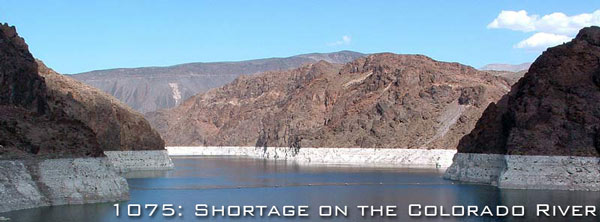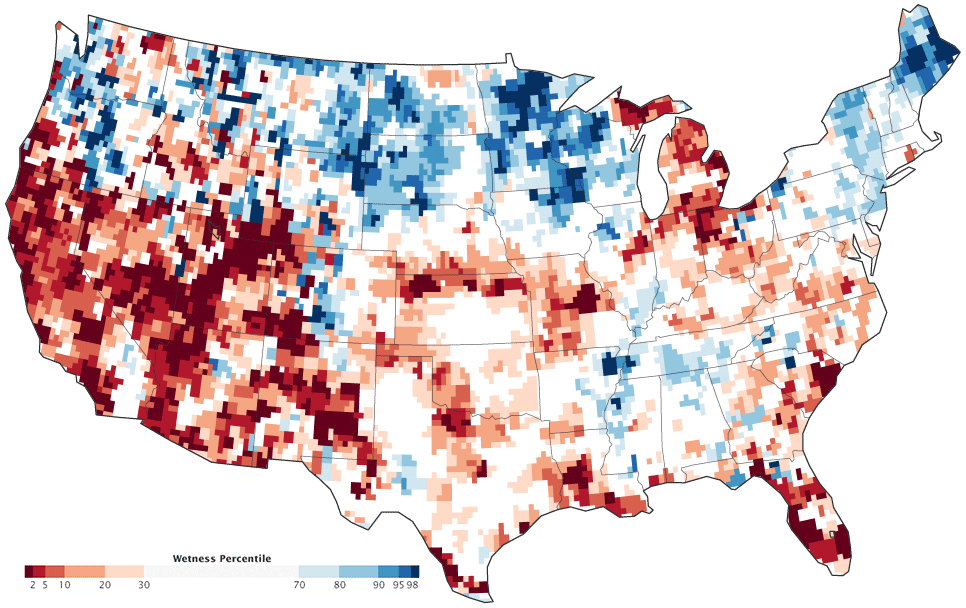Recap: Drought and Water Supplies in the Southwest - 1075' Shortage on the Colorado River

This week, we released the 5th episode in the CLIMAS podcast series[1] 1075' - Shortage on the Colorado River, which explores what a shortage declaration on the Colorado River would mean to those living in the Southwest. 1075 refers to the elevation of Lake Mead – in feet above sea level – that serves as the trigger for shared shortage restrictions[2]. Any shortage declaration before 2026 would be the first under the 2007 Interim Guidelines[3]. After years of drought and ever-increasing demands on the river, the latest projections from the Bureau of Reclamation suggest the lake could drop below 1075 sometime in 2015.
Water availability and potential shortages are a persistent concern for the Southwest, and careful management and creative conservation efforts are a requisite part of a sustainable water use plan for the region. We knew this was a timely and relevant issue when we planned and recorded the series over spring and summer 2014, but we didn't anticipate the media frenzy that led to more sensationalistic media coverage of Lake Mead levels specifically, and water issues in the west more generally.
The media attention reinforced our goal of "attempting to demystify the rules and regulations that govern water use on the Colorado River and discuss what it means to the people and sectors across Arizona when a shortage occurs..." and of "exploring the opportunities and consequences of a shortage to construct a nuanced view of a complex issue." The negative side is often what receives the most attention. But, perhaps a shortage will spur innovation and lead to better conservation that saves money. At the most fundamental level, we wanted to know if Lake Mead falling below 1075 would be looked back upon as a moment in history that 'changed everything' or if this seemingly inevitable moment would feel a lot like the Y2K craze.
We turned to regional water experts to help us better understand Southwest water supply issues, the Central Arizona Project, realities of water management, opportunities for conservation, and details on what will actually happen if - and more likely when - a shortage declaration is made in the next few years.
Episodes
- In Episode 1: Management of the Colorado River, Zack Guido and Ryan Thomas interview Doug Kenney about the management and history of the Colorado River, who uses the water, and what a potential shortage could mean for the system. This is an excellent and detailed overview of Colorado River management issues, and is an excellent foundation for subsequent episodes.
- In Episode 2: Stressors on the River, Zack sits down with Bonnie Colby, Geroge Frisvold, and Kiyomi Morino to discuss specific stressors on the Colorado River Basin, how these stressors may change over time, and how these changes may affect management and behaviors across the Southwest.
- In Episode 3: Shortage Impacts on the Central Arizona Project, Zack and Ryan are joined by Mohammed Mahmoud of the Central Arizona Project (CAP) to the role that CAP plays in delivering Colorado River water throughout Arizona, as well as implications for the CAP system if/when a shortage declaration is made.
- In Episode 4: The Central Arizona Groundwater Replenishment District Zack interviews Dennis Rule of the Central Arizona Groundwater Replenishment District (CAGRD), to get into details about the CAGRD in the management of Arizona groundwater, and potential impacts on the system from continued drought in the Colorado River Basin.
- In Episode 5: Tucson Water and Municipal Water Issues Zack sits down with Alan Forrest, the Director of Tucson Water, and they discuss strategies that Tucson implemented to deal with potential water shortages, the conservation and recapture efforts of municipalities in Southern Arizona, and the practical realities of providing municipal water to an growing population in the southwest.
Background
These issues (Lake Mead levels, water management concerns, etc.) didn't pop up out of nowhere. The social, environmental, and management context are the backstory - and the experts we interviewed helped us capture some of the nuance, but it's also important to highlight a few threads that contributed to the ongoing conversation.

Stories and reports about drought conditions, especially in California and Texas, brought contemporary water issues to the forefront over the past year or so [4]. Attention ramped up this spring and summer as media outlets picked up in on a new study highlighting higher than predicted groundwater consumption estimates, especially in the southwest (see this map). Media coverage focused on this story, as well as the drop in water levels at Lake Mead, often conflating groundwater and surface/allocation water issues. Coverage veered into the sensational, as stark images of dry conditions dominated the coverage, while the headlines were filled with portents of doom. The added attention can help bring energy and ideas to critical issues in need of timely solutions, but it can also confuse audiences when they see headlines predicting societal and environmental collapse. These problems persist long after media attention has waned, and managers must respond to the aftermath of this style of coverage, focusing on practical solutions and maintaining good working relationships with a diverse network of stakeholders (some of whom are alienated from the process by overly binary or simplistic pronouncements of any political flavor).
As is often the case, this wasn't even the first time this had been written about in detail, and a number of journalists and scientists have been giving this issue careful consideration as it unfolds. John Fleck has been tracking this issue in detail, and has a number of insightful posts (Lower CO Basin New Years Resolution - 2012 - The Colorado River Doomsday Clock - 2013), including a one earlier this summer detailing CAP strategies for management, and his most recent entry addressing specific challenges (and possible implications) of the results outlined in the Castle et al. study. Fleck also wrote about policy implications for this study, detailing flexibility in the Colorado River System thus far, as well as how groundwater usage complicates management plans and outcomes. Brian Devine wrote about the consequences of agricultural to municipal water transfers, as well as more general questions about conservation, and Doug Kenney and Kimery Wiltshire used the record low level in Lake Mead to frame a discussion of implications for shortages and strategies for management and conservation.
The point? - a number of people have been thinking about this for a long time - and we hope that by turning to a few of these experts, both in the framing of why we did this podcast, and who we were able to bring in for conversations, we can present a nuanced take on the very real challenge of water management in the Southwest, but without losing sight of the strategies that have worked and are working to protect this limited resource. Stay tuned - we plan to expand this conversation to include additional perspectives on this issue.
Notes
- We may do a second "season" given all the interest in the series, especially since there are numerous other experts we would love to talk to, and other sectors (e.g. ranching, agricultural, industrial) that we would like to include in the conversation.
- Note: Mead elevation falling below 1075' in a given month does not automatically trigger shortage restrictions. The January 1st forecast from the August 24-month study is the Mead elevation value that determines if a Tier 1 Lower Basin shortage will occur. The 24-month study is a monthly report produced by the Bureau of Reclamation to keep track of Colorado River system reservoirs. So even if Lake Mead is forecasted to drop below 1075' in mid-2015, shortage is not declared unless the 2014 August 24-month study forecasts a January 1st Mead elevation at or below 1075'.
- There was a shortage declared in 1963/1964 when Lake Powell was filling. Drought caused low inflows into Lake Mead and deliveries to the Lower Basin were subsequently cut.
- There was some hope that a stronger El Niño might alleviate some of the drought conditions, but as predictions for a strong El Niño event have waned, so has that optimism.
Many thanks to Dr. Mohammed Mahmoud (of the Colorado River Programs / Central Arizona Project) for providing the clarifications in footnotes [2-3].

